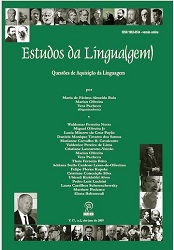Repensando os efeitos de idade no desenvolvimento fônico de L2 (Rethinking the effects of age on L2 phonic development)
DOI:
https://doi.org/10.22481/el.v17i2.5340Palavras-chave:
Desenvolvimento fônico; Segunda língua; Período crítico; Input.Resumo
Uma das preocupações mais presentes na área da aquisição de L2 diz respeito à idade do início do bilinguismo/aquisição (AOA). Estudos clássicos apontam para uma correlação negativa entre AOA e acurácia e proficiência na L2. Contudo, pesquisas experimentais mais recentes têm problematizado essa hipótese. Nessa perspectiva, este trabalho, resultado de pesquisa financiada pelo CNPq, apresenta dados do desenvolvimento de L2 por imigrantes em contextos de L2-dominante que contrariam a ideia de que o sucesso do desenvolvimento fônico na L2 está condicionado à maturação neurocognitiva. Os dados revelam que a variação no input é a variável mais importante na predição de sucesso no desenvolvimento de uma L2. Assim, o potencial de AOA como uma variável de previsão de sotaque estrangeiro ou sucesso na L2 vem de sua associação com a quantidade e qualidade de inputs recebidos pelos imigrantes/aprendizes.
Downloads
Referências
BECKNER, C. et al. Language is a complex adaptive system: position paper. Language Learning, v. 59, n. 1., p. 1-26, Dec., 2009.
BEN-RAFAEL, M.; SCHMID, M. Language attrition and ideology: Two groups of immigrants in Israel. In KOPKE, B.; SCHMID, M. S., KEIJZER, M.; DOSTER, S., (ed). Language attrition: Theoretical Perspectives, Amsterdam/Philadelphia: John Benjamins, 2007, p. 205-226.
BEST, C.; TYLER, M. Nonnative and second-language speech perception: commonalities and complemen- tarities. In: BOHN, O.; MUNRO, M.. Language Experience in Second Language Speech Learning: In honor of James Emil Flege. Amsterdam: John Benjamins, 2007. p. 13-34.
BIRDSONG, D. Interpreting age effects in second language acquisition. In. KROLL, J.; GROOT, A. (Eds). Handbook of bilingualism: Psycholinguistic perspectives. Oxford: Oxford University Press, 2005, p. 109-127.
BYBEE, J. Phonology and Language Use. Cambridge: Cambridge Univ. Press., 2001.
CHISWICK, B.; MILLER, P. (2001) A model of destination language acquisition: Application to male immigrants in Canada. Demography, 38 (3), p. 391-409, 2001.
De LEEUW, E. 2014, Maturational constraints in bilingual speech. In THOMAS E. M.;
EVANS, B.; IVERSON, P. Vowel normalization for accent: An investigation of best exemplar locations in northern and southern British English sentences, J. Acoustical Soc. America, 115, 352– 361, 2004
FLEGE, J. E. Second language speech learning: Theory, findings, and problems. In
GARDNER, R. C. Social Factors in Language Retention. In: R. D. Lambert & B. F. Freed (eds.). The Loss of Language Skills. Rowley: Newbury House, 1982, p. 24-39.
GIBSON, J. The ecological approach to visual perception. Boston: Houghton Mifflin, 1979.
HAUGEN, E. The ecology of language. In FILL, A.; MÜHLHÄUSLER. P. (Orgs.) The ecolinguistics reader (p. 57-66). London: Continuum, 2001.
HOPP, H.; SCHMID, M. S. Perceived foreign accent in L1 attrition and L2 acquisition: the impact of age of acquisition and bilingualism. Applied Psycholinguistics., 2013.
JOHNSON, J.; NEWPORT, E. Critical period effects in second language learning: The influence of maturational state on the acquisition of English as a second language. Cognitive Psychology, 21(1), p. 60–99, 1989.
KUPSKE, F.. Imigração, Atrito e Complexidade: a produção das oclusivas surdas iniciais do inglês e do português por brasileiros residentes em Londres. (Doctoral Dissertation) Universidade Federal do Rio Grande do Sul, Porto Alegre, Brazil, 2016.
______. A complex approach on integrated late bilinguals English VOT production: a study on south Brazilian immigrants in London. Ilha do Desterro, v. 70, p. 81-94, 2017.
______. Atrito de L1 por assimilação de categorias fonéticas da L2 na produção da fala de imigrantes de primeira geração. In: ATAIDE, C. A.; SOUSA, V. V.. (Org.). Língua, texto e ensino: descrições e aplicações. 1ed. Recife: Pipa Comunicação, 2018, p. 605-614.
LENNEBERG, E. Biological Foundations of Language, New York: Wiley, 1967.
MASGORET, A.; GARDNER, R. Attitudes, motivation, and second language learning: A meta-analysis of studies conducted by Gardner and Associates. Language Learning, 53(1), p. 123-163, 2003.
MCCARTHY, K.; EVANS, B.; MAHON, M. Acquiring a second language in an immigrant community: The production of Sylheti and English stops and vowels by London-Bengali speakers. Journal of Phonetics, 41, p.344–358, 2013.
MOYER, A. Ultimate attainment in L2 phonology. Studies in Second Language Acquisition, 21, 81–108. 2009.
MUÑOZ, C.; SINGLETON, D. Foreign accent in advanced learners. Two successful profiles. The EUROSLA Yearbook 7, p. 171-190, 2007.
OPITZ, C. First language Attrition and Second Language Acquisition in a Second- Language Environment. PhD dissertation, Trinity College Dublin, 2011.
SANCIER. M. L.; FOWLER, C. A. Gestural drift in a bilingual speaker of Brazilian Portuguese and English. Journal of Phonetics, 27 (4), p. 421–436, 1997.
SCHMID, M. Second Language Attrition. In BROWN, K. (Ed.). The Encyclopedia of Language and Linguistics, (Vol. 11, p. 74-81). Amsterdam: Elsevier. 2006.
______; de BOT, K. Language Attrition. In DAVIES, A.; ELDER, C. (Eds.), The Handbook of Applied Linguistics. Oxford: Blackwell Publishing, 2006, p. 210-234.
______; MEHOTCHEVA, T. H. Foreign Language Attrition. Dutch Journal of Applied Linguistics, 1 (1), p. 102-124, 2012.
______; GILBERS, S; NOTA, A. Ultimate attainment in late second: Phonetic and grammatical challenges in advanced Dutch-English bilingualism. Second language research, 30(2), p. 129-157, 2014 <DOI: 10.1177/0267658313505314>
STEVENS, G. Age at immigration and second language proficiency among foreign-born adults. Language in Society, 28, p. 555-578, 199.
______. The Age‐Length‐Onset Problem in Research on Second Language Acquisition Among Immigrants. Language Learning, 56 (4), p. 671–692, 2006
SINGLETON, D.; RYAN, L. Language Acquisition: The Age Factor. Second Edition. Clevedon: Multilingual Matters, 2004.
VAN HOUT, R.; STROMQUIST, V. The Influence of Socio-Biographical Factors. Adult Language Acquisition. Cross-linguistic perspectives. C. Perdue. Cambridge, Cambridge University Press. 1:p.164-172., 1993.
van TUBERGEN, F. Determinants of second language proficiency among refugees in the Netherlands. Social Forces, 89(2), p. 515–534, 2010.
______; WIERENGA, M. The language acquisition of male immigrants in a multilingual destination: Turks and Moroccans in Belgium. Journal of Ethnic and Migration Studies, 37(7), p. 1039–1057, 2011.
VENTUREYRA, V.; PALLIER, C., YOO, H. The loss of first language phonetic perception in adopted Koreans. Journal of Psycholinguistics, 17, p. 79–91, 2004.
YILMAZ, G.; SCHMID, M. Second Language Development in a Migrant Context: Turkish community in the Netherlands. International Journal of the Sociology of Language, 236, p. 101-132, 2015.
ZIMMER, M.; ALVES, U. A produção de aspectos fonético-fonológicos da segunda língua: instrução explícita e conexionismo. Linguagem & Ensino (UCPel), v. 9, p. 101-143, 2006.
Downloads
Publicado
Como Citar
Edição
Seção
Licença
Autores que publicam em Estudos da Língua(gem) concordam com os seguintes termos:
Estudos da Língua(gem) mantém os direitos autorais das contribuições publicadas e disponibiliza seu conteúdo gratuitamente por meio do portal. Autores têm permissão e são estimulados a publicar e distribuir seu trabalho online em repositórios institucionais ou na sua página pessoal, com reconhecimento de autoria e créditos de publicação inicial nesta revista, indicando endereço online.












